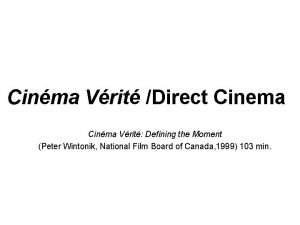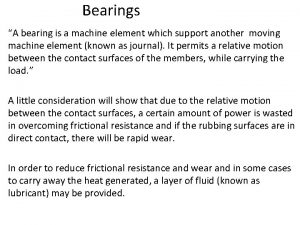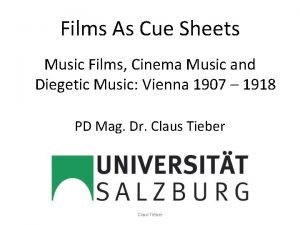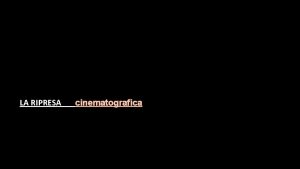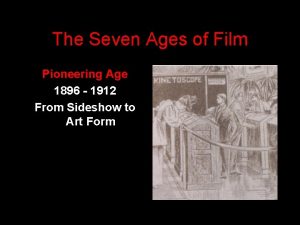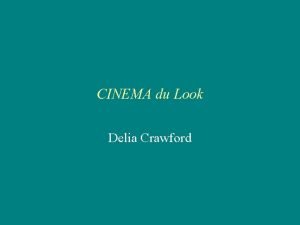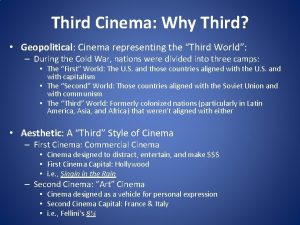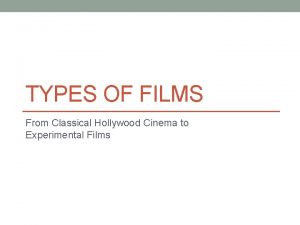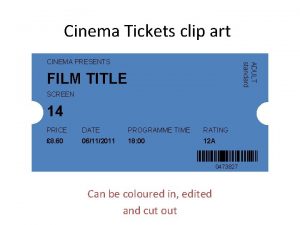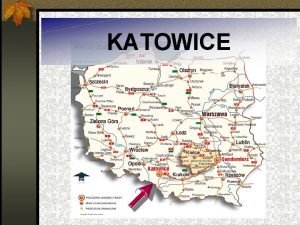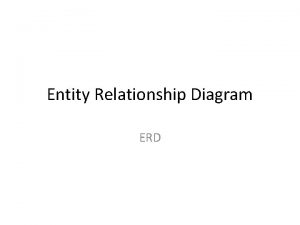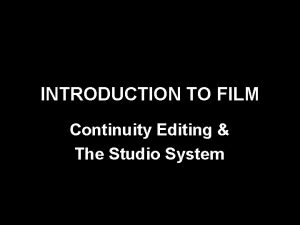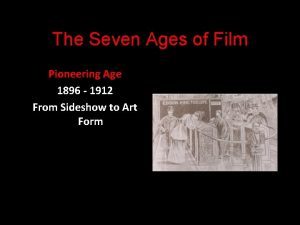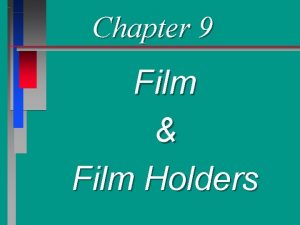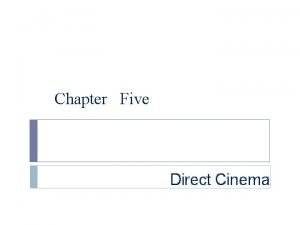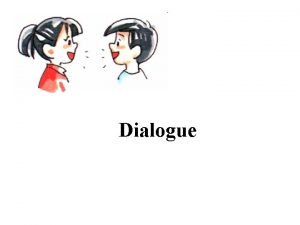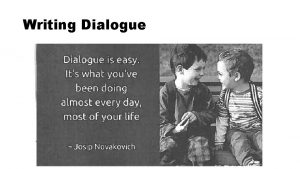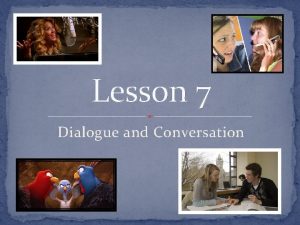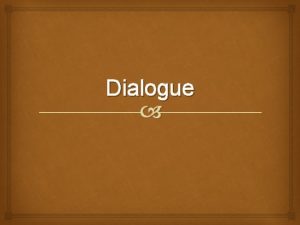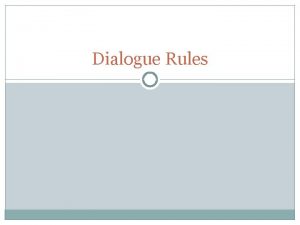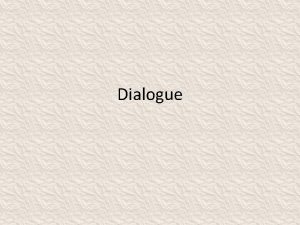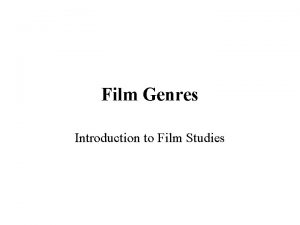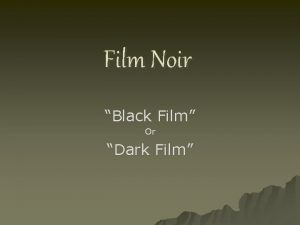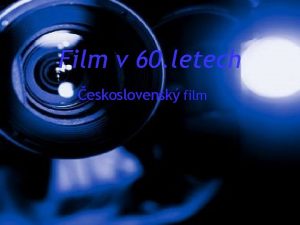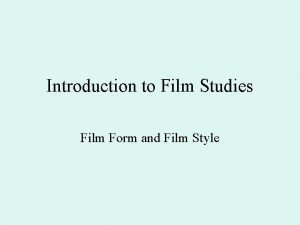Film as a Dialogue Interpreting cinema Marc Adang
































- Slides: 32

Film as a Dialogue Interpreting cinema Marc Adang en Gerwin van der Pol

Film as a Dialogue Interpreting cinema Introduction

What does it mean to watch a film? o Difference between ‘ordinary’ filmviewing, and what a researcher does. o The ordinary filmviewer understands and interprets, o The researcher does the same, but does it systematically, and reflects on the whole process o Film interpretation= to analyse + to signify o Film interpretation = also, a lengthy process of asking questions, search for answers, and testing conclusions

Dialogue with theory o Theories can offer models to gain insight in a facet of the film. o The same theory, applied to different films, results in different answers. o Different theories, applied to the same film, can lead to the same insight. o Every method, theory or model can be applied on a film, but that doesn’t necessarily mean that every theory is equally useful.

Film as a dialogue o o Preface A. Introduction o o B. Filminterpretation n n o 1. A film is a dialogue I. Preliminary orientation o 2. Acquaintance with the film o 3. Asking questions II. Time and space o 4. Time o 5. Space III. Characters, Relations, development o 6. Characters o 7. Relations o 8. Development IV. Interpretation o 9. Interpretation C. References

Film as a Dialogue Interpreting cinema Part A. A film is a Dialogue

A film is a dialogue o The same film is different: n Before n During n After o Understanding takes place on three different levels: n Diegesis n Film n Reception

Film as a dialogue o o Preface A. Introduction o o B. Filminterpretation n n o 1. A film is a dialogue I. Preliminary orientation o 2. Acquaintance with the film o 3. Asking questions II. Time and space o 4. Time o 5. Space III. Characters, relations, development o 6. Characters o 7. Relations o 8. Development IV. Interpretation o 9. Interpretation C. References

Acquaintance with the film o First, pre-systematic analysis o Constant adjustments, corrections and additions during the course of studying the film. o Chart of scenes o Synopsis o Characterization of the film

Chart of scenes o Comparable to a chart of scenes in drama o But now made by the researcher o Not a complete text o More non-verbal information + Indices o Spreadsheet, 11 columns

Chart of scene/spreadsheet 1. concrete information o o Scène numeration and time code Who? (descriptive) Where? (descriptive) What? (descriptive)

Chart of scenes/spreadsheet 2. interpretation o segmentation o o o Indices Indices and and and problems problems of of of time space characters relations development o Indices and problems of themes

Synopsis o

Characterization o First attempt to characterize the film o First basis for further observations

Characterize: fictionality Fake/implausible Fantasizing (Fabulating) Didactic True/plausible

The plastic bag o http: //www. youtube. com/watch? v=G Lgh 9 h 2 e. PYw&playnext=1&list=PLE 2 D 698 ED 898 D 95 E 7

Characterize: fictionality Fake/implausible Fiction Fantasizing (Fabulating) Didactic Nonfiction True/plausible

Characterize: genre

Characterize: style o Style is content

Characterize: Style Realism Expressionism Classicism

Characterize: ambition level Conventional filmic Conforming to the system cial/ cultural Complex/ modernizing So Critical/expl oring/perso nal

Characterize: context o Filmmakers: n n Director Producer Most important crew members Actors o Production and distribution o Historical/ geographical

3. Asking the right question o Questions on the level of diegesis n Perception n Semiotics o Questions on the level of the film n Function of filmic means n Understanding how the film cues the spectator to understand the diegesis in a certain way o Questions on the level of the reception n What are effects on the spectator? n How does he understand the film? n What kind of emotions are evoked? n In what kind of aesthetic judgment does the film result? n in what kind of moral judgment does the film result?

Film as a dialogue o o Preface A. Introduction o o B. Filminterpretation n n o 1. A film is a dialogue I. Preliminary orientation o 2. Acquaintance with the film o 3. Asking questions II. Time and space o 4. Time o 5. Space III. Characters, Relations, development o 6. Characters o 7. Relations o 8. Development IV. Interpretation o 9. Interpretation C. References

Time o Time in the diegesis n Space of time n Situating o Space of time of the film n Diegetic time compared to film time n segmentation o Interpreting time

Space o Diegetic space: n Construction n meaning o De filmic space n construction n Meaning o The relation between diegetic and filmic space o Interpretation of space


Film as a dialogue o o Preface A. Introduction o o B. Filminterpretation n n o 1. A film is a dialogue I. Preliminary orientation o 2. Acquaintance with the film o 3. Asking questions II. Time and space o 4. Time o 5. Space III. Characters, Relations, development o 6. Characters o 7. Relations o 8. Development IV. Interpretation o 9. Interpretation C. References

7. characters 8. Relations 9. Development Diegesis appearance Psychologic social Emotional relations Social relations - Film Construction Design Structure of engagement construction Semantic characters Structure of engagement Construction and design Reception Empathy, judgment Taking sides in relations Judgments on relations Judgments about acts, empathy with certain characters. Judgment about certain choices from the filmmaker, empathy with filmmaker deeds acts evolutions events

Film as a dialogue o o Preface A. Introduction o o B. Filminterpretation n n o 1. A film is a dialogue I. Preliminary orientation o 2. Acquaintance with the film o 3. Asking questions II. Time and space o 4. Time o 5. Space III. Characters, Relations, development o 6. Characters o 7. Relations o 8. Development IV. Interpretation o 9. Interpretation C. References

Final interpretation o Thematic analysis n Using indices as starting point o Characterization n Retaking the earlier characterization and now drawing clearer conclusions

Characterize: context and position o Filmmakers: n Position within their own oeuvre o Historical, geographical n Influences n Position within political debate n Position within film history o Nachleben n Changes in meaning of the film
 Adang suhendra
Adang suhendra La vrit
La vrit Dialogue cinéma
Dialogue cinéma Expressions of congratulation
Expressions of congratulation Explain wedge film and squeeze film journal bearings
Explain wedge film and squeeze film journal bearings Teatro 9 ano
Teatro 9 ano Bajo la misma luna where to watch
Bajo la misma luna where to watch Claus tieber
Claus tieber Zoopraxiscopi
Zoopraxiscopi Campo totale cinema
Campo totale cinema The pioneering age of film was started in the year
The pioneering age of film was started in the year Cinema du look films
Cinema du look films Third world
Third world Elements of classical hollywood cinema
Elements of classical hollywood cinema Uci cinema pdr
Uci cinema pdr Realismo francese cinema
Realismo francese cinema Cinema ticket clipart
Cinema ticket clipart Marquee cinemas orchard 14
Marquee cinemas orchard 14 What is the capital of hollywood
What is the capital of hollywood Modern cinema
Modern cinema Cineblaster
Cineblaster Cogitatur katowice
Cogitatur katowice Sesso cinema
Sesso cinema Chen erd
Chen erd Spartak cinema
Spartak cinema Continuity editing is a system for
Continuity editing is a system for Who invented the cinema
Who invented the cinema Direct cinema definition
Direct cinema definition Japanese new wave movies
Japanese new wave movies Seven ages of cinema
Seven ages of cinema Digital cinema design
Digital cinema design Spoglio sceneggiatura modello
Spoglio sceneggiatura modello Magistrale cinema
Magistrale cinema

